Related Research Articles
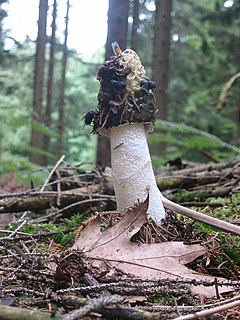
Phallaceae is a family of fungi, commonly known as stinkhorn mushrooms, within the order Phallales. Stinkhorns have a worldwide distribution, but are especially prevalent in tropical regions. They are known for their foul-smelling, sticky spore masses, or gleba, borne on the end of a stalk called the receptaculum. The characteristic fruiting-body structure, a single, unbranched receptaculum with an externally attached gleba on the upper part, distinguishes the Phallaceae from other families in the Phalalles. The spore mass typically smells of carrion or dung, and attracts flies, beetles and other insects to help disperse the spores. Although there is great diversity in body structure shape among the various genera, all species in the Phallaceae begin their development as oval or round structures known as "eggs". According to a 2008 estimate, the family contains 21 genera and 77 species.

Hyaline cartilage is the glass-like (hyaline) but translucent cartilage found on many joint surfaces. It is also most commonly found in the ribs, nose, larynx, and trachea. Hyaline cartilage is pearl-grey in color, with a firm consistency and has a considerable amount of collagen. It contains no nerves or blood vessels, and its structure is relatively simple.

Parantica aglea, the glassy tiger, is a butterfly found in Indomalayan realm that belongs to the crows and tigers, that is, the danaid group of the brush-footed butterflies family.
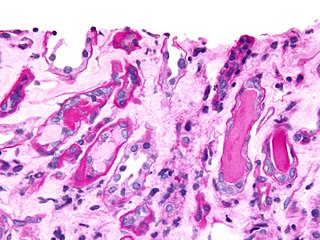
Urinary casts are microscopic cylindrical structures produced by the kidney and present in the urine in certain disease states. They form in the distal convoluted tubule and collecting ducts of nephrons, then dislodge and pass into the urine, where they can be detected by microscopy.

Caprona alida, the yellow spotted angle or Alida angle, is a butterfly belonging to the family Hesperiidae. It is found in India, Sri Lanka, Myanmar, Thailand, Vietnam, Laos, Hainan and southern China. It was first described by Lionel de Nicéville in 1891.

Parnassius jacquemontii, the keeled Apollo, is a high altitude butterfly which is found in India and Pakistan. It is a member of the snow Apollo genus (Parnassius) of the swallowtail family (Papilionidae). It is also fairly common at high altitudes from Chitral to Kumaon.

Tirumala gautama, the scarce blue tiger, is a butterfly species found in India and Southeast Asia that belongs to the "crows and tigers", that is, the danaid group of the brush-footed butterflies family.
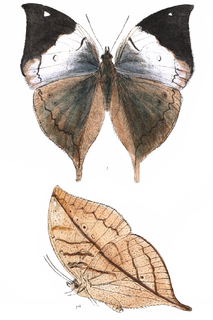
Kallima knyvetti, the scarce blue oakleaf, is a species of leaf mimic butterfly found in Southeast Asia.

Kallima albofasciata, the Andaman oakleaf, is a species of oak leaf butterfly found in the Andaman Islands.

Cartilaginous joints are connected entirely by cartilage. Cartilaginous joints allow more movement between bones than a fibrous joint but less than the highly mobile synovial joint. Cartilaginous joints also forms the growth regions of immature long bones and the intervertebral discs of the spinal column.

Psilocybe aztecorum is a species of psilocybin mushroom in the family Hymenogastraceae. Known from Arizona, Colorado, central Mexico, India and Costa Rica, the fungus grows on decomposing woody debris and is found in mountainous areas at elevations of 2,000 to 4,000 m, typically in meadows or open, grassy conifer forests. The mushrooms have convex to bell-shaped caps 1.5–2 cm (0.6–0.8 in) in diameter, atop slender cylindrical stems that are up to 7.5 cm (3.0 in) long. The color of the caps changes with variations in hydration, ranging from dark chestnut brown to straw yellow or whitish when dry. The base of the stem is densely covered with conspicuous white rhizomorphs, a characteristic uncommon amongst Psilocybe species.

Mycena multiplicata is a species of mushroom in the family Mycenaceae. First described as a new species in 2007, the mushroom is known only from Kanagawa, Japan, where it grows on dead fallen twigs in lowland forests dominated by oak. The mushroom has a whitish cap that reaches up to 13 mm (0.51 in) in diameter atop a slender stem 15 to 20 mm long by 1 to 1.3 mm thick. On the underside of the cap are whitish, distantly spaced gills that are narrowly attached to the stem. Microscopic characteristics of the mushroom include the amyloid spores, the pear-shaped to broadly club-shaped cheilocystidia covered with a few to numerous, unevenly spaced, cylindrical protuberances, the lack of pleurocystidia, and the diverticulate hyphae in the outer layer of the cap and stem. The edibility of the mushroom is unknown.
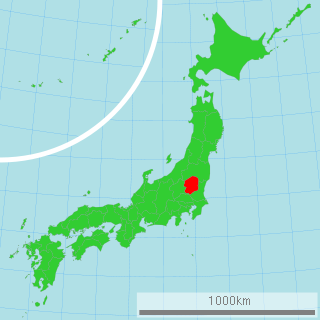
Aseroe coccinea is a species of stinkhorn fungus in the genus Aseroe. First reported in Japan in 1989, it was not formally validated as a species until 2007, the delay related to a publication error. The receptacle, or fruit body, begins as a partially buried whitish egg-shaped structure, which bursts open as a hollow white stipe with reddish arms, then erupts and grows to a height of up to 15 mm (0.6 in). It matures into a star-shaped structure with seven to nine thin reddish tubular "arms" up to 10 mm (0.4 in) long radiating from the central area. The top of the receptacle is covered with dark olive-brown spore-slime, or gleba. A. coccinea can be distinguished from the more common species A. rubra by differences in the color of the receptacle, and in the structure of the arms. The edibility of the fungus has not been reported.

Tuber oregonense, commonly known as the Oregon white truffle, is a species of edible truffle in the genus Tuber. Described as new to science in 2010, the North American species is found on the western coast of the United States, from northern California to southern British Columbia west of the Cascade Range. A mycorrhizal fungus, it grows in a symbiotic association with Douglas fir. It overlaps in distribution with the closely related T. gibbosum, but they have different growing seasons: T. oregonense typically appears from October through March, while T. gibbosum grows from January to June. The fruit bodies of the fungus are roughly spherical to irregular in shape, and resemble small potatoes up to 5 cm (2 in) in diameter. Inside the truffle is the gleba, which is initially white before it becomes a marbled tan color. The large, often thick-walled, and strongly ornamented spores are produced in large spherical asci. The truffle is highly prized for its taste and aroma. Some individuals have claimed success in cultivating the truffles in Christmas tree farms.
Leucoblepsis neoma is a moth in the family Drepanidae. It was described by Swinhoe in 1905. It is found in Singapore and on Peninsular Malaysia, Sumatra and Borneo.
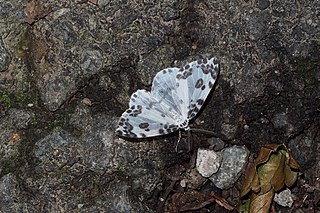
Deroca inconclusa is a moth in the family Drepanidae. It was described by Francis Walker in 1856. It is found in northern India, Myanmar, China and Japan.

Pluteus americanus is a North American and Russian psychedelic mushroom that grows on hardwoods.
Antaeotricha mesosaris is a moth of the family Depressariidae. It is found in French Guiana.
Caeneressa tienmushana is a species of moth in the family Erebidae. It was described by Obraztsov in 1957. It is found in China.
Parascaeas is a monotypic moth genus in the family Depressariidae. Its only species, Parascaeas uranophanes, is found in Panama and Colombia. Both the genus and species were first described by Edward Meyrick, the genus in 1936 and the species five years earlier in 1931.
References
- ↑ "GlobIZ search". Global Information System on Pyraloidea. Retrieved 2014-07-15.CS1 maint: discouraged parameter (link)
- ↑ List of the Specimens of Lepidopterous Insects in the Collection of the British Museum 34: 1376